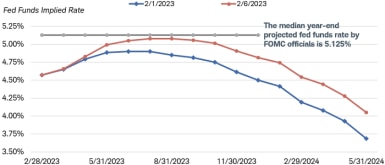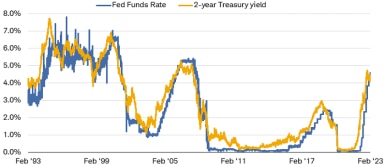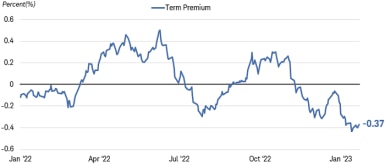Mind the Gap: Bond Yields Appear Set for a Rebound

The post-pandemic economy continues to deliver surprises to the markets. From global supply-chain disruptions to surging inflation, this cycle has been unique. So it's fitting that just when the markets were discounting slowing growth and disinflation, the January unemployment report delivered another shock. Benchmark revisions to the employment data showed that job growth was much stronger over the past few years than previously reported, signaling the potential for consumer demand to support economic growth.
Coming into the year, signs of slowing economic growth and declining inflation helped spur a rally in bonds that saw Treasury yields fall by more than 80 basis points from peak to trough (a basis point is one-hundredth of a percentage point, or 0.01%, so 80 basis points equals 0.80%). Notably, the rally opened up a wide gap between what the Federal Reserve was signaling as the likely course of its interest rate policy and what the market was discounting.
This gap has been one of the concerns we've been highlighting as a potential source of volatility, The market simply wasn't buying the idea that the Federal Open Market Committee (FOMC) would hike the Fed's benchmark federal funds rate target to a range of 5.0% to 5.25% and hold it there all year. It was pricing in a lower peak federal funds rate, with rate cuts by the end of the year. It's now priced for a higher fed funds rate and only a modest cut in rates by the end of the year. That's still shy of what the Fed's most recent projections suggest—but the gap has narrowed significantly.
Market expectations for the federal fund rate changed after the last Fed meeting
Source: Bloomberg. Market estimate of the federal funds rate using Fed Funds Futures Implied Rate (FFM2 COMB Comdty). As of 2/1/2023 and 2/6/2023, respectively. For illustrative purposes only.
Not all yields are created equal
Over the next few months, we see room for yields to move higher, especially if the inflation data come in stronger than anticipated. Short-term interest rates, which track the federal funds rate, have already jumped by 25 to 40 basis points from recent lows. It's likely that yields for bonds with two- to five-year maturities will continue to move higher on the shift in expectations about the path of Fed policy.
The Fed will release a new set of economic projections at its March meeting, but we don't expect a downshift in its projections for the fed funds rate given the recent strong job data. Fed officials have repeatedly cited the tight labor market as a worry and have continued to emphasize that they will keep monetary policy on a tightening path until it is clear that inflation is heading back down to its 2% target.
Historically the two-year Treasury yield has generally tracked the federal funds rate
Source: Bloomberg, as of 2/6/2023.
Effective Federal Funds Rate, (FEDL01 Index) and 2-Year Treasury Constant Maturity Rate, Percent, Monthly, Not Seasonally Adjusted (USGG2YR Index). Past performance is no guarantee of future results.
Intermediate-and long-term rates are likely to rise in the near term, as well. Looking at a breakdown of the drivers of 10-year Treasury yields suggests that about half of the decline since the October peak reflects expectations about a drop in short-term rates. This is referred to as the "term premium," or the extra compensation an investor gets for locking up money for a longer time frame versus rolling over short-term bonds.
From the peak in 10-year Treasury yields in late October at 4.33%, the term premium has fallen by about 75 basis points. Recapturing half of that decline would mean a rebound in nominal yields to roughly 3.75% to 4.0%, all else being equal. We think that's a reasonable expectation.
The 10-year Treasury term premium has fallen since October 2022
Source: Federal Reserve. U.S. Term Premium on a 10-year coupon bond. Daily data as of 1/27/2023.
Note: The term premium is the compensation that investors require for bearing the risk that short-term Treasury yields do not evolve as they expected. The term premium is obtained from the Kim-Wright term structure model of U.S. interest rates.
Of course all else is rarely ever equal. When it comes to Treasury bonds, there are other factors that affect yields—including expectations about the path of economic growth, and the level of demand from domestic and foreign investors. In general, we still see economic growth remaining slow due to the lagged impact of the Fed's rate hikes to date, inflation continuing to abate, and demand staying relatively stable. Consequently, much of the adjustment we're expecting in yields is focused on the term premium.
Rising yields offer potential opportunity
We see a rebound in yields as an opportunity for investors who have been hesitant to invest in intermediate-term or longer-term bonds. Over the long run, we expect inflation to continue to fall in response to the monetary tightening that's already in place. Disinflation is already occurring in the goods sector. It will likely spread to the service sector as the Fed tightens policy further.
If we're right that yields are likely to rise, then it makes sense to focus on higher-credit-quality bonds. The recent rally in the fixed income markets has led to decline in credit spreads (the difference in yield between corporate bonds and Treasuries of comparable maturity). Higher interest rates raise the cost of financing for companies. Those with the lowest credit ratings—such as high-yield bonds—are vulnerable to a correction.
In sum, we still believe fixed income will produce positive returns in 2023. However, there will likely be a fair amount of volatility along the way. We should expect more surprises, but suggest that investors looking to lock in higher yields for the next few years consider using the expected rebound in intermediate- to long-term rates to add to duration to their portfolios.
 By
By


